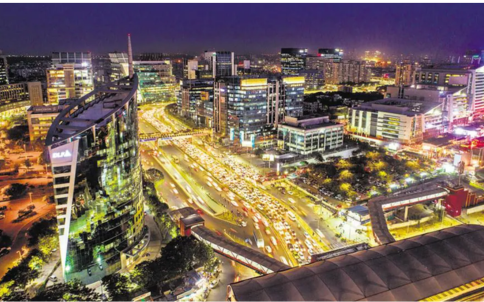Photo writeup: Gurugrm, A metropolis carved out of sleepy villages
Musings by Shekhar Nambiar
I have seen Bangalore and Delhi grow into mega cities, transforming themselves beyond recognition. Visit either city after a gap pf six months and it’d be difficult to wend your way across the streets. Such has been their growth.
Bombay, or Mumbai, was always big and more urban and cosmopolitan than any other Indian city. Its growth was linear, being a narrow stretch of land and a group of islands linked to each other with the open sea on one side and the bay on the east.
Also read: A mission revisited
The exception to the linear growth of the city’s suburbs is Navi Mumbai on the northern shores of the Bay. On its own, Belapur and surroundings have become a satellite city, so to speak, of the Bombay we knew.

Commerce Mumbai’s mainstay
With its own set of companies and their headquarters, Navi Mumbai has also become the hub of entertainment and sporting events. Panvel has become a major railway terminal and also the starting point of the Konkan Railway that links Mumbai to Goa, Mangalore, Kerala and beyond.
Commerce has always been the mainstay of the city attracting Indians from every part. And so, development was centred around companies, big and small, that set up shop in Mumbai.
Also read: China is watching
In the mid-seventies came the major development off Mumbai with Nava Sheva or Jawaharlal Nehru Port hidden behind the hills of Elephanta Caves, an outcrop jutting into the sea and a mere 30-minute boat ride from Gateway of India.

Delhi’s development
Delhi, on the other hand, used to be looked down upon as an overgrown village, nothing more than regional and even parochial. With Partition came new development of colonies and localities. It was also considered too bureaucratic. So, everybody who was a somebody, could not ignore it completely. It was the Mecca for vested interests and those who wanted to hobnob or be seen with politicians of all shades and opinion.
Newly independent India embarked on mammoth development schemes. With it came new Ministries and the government apparatus in Delhi commensurately expanded, opening vast employment opportunities.
Also read: When it rains, it pours
Amid the old Gole Market and Lodi Colony, numerous other government colonies were developed, and the more prominent of these, Vinay Nagar, Andrews Ganj, Naoroji Nagar and RK Puram, remain to this day.

Gurugram’s rise
Then came the New Economy, the IT revolution and Gurugram, next door to Delhi, and now part of the National Capital Region. It would seem the city sprung up from nowhere to become a global destination, although Gurugram was always there as a small town.
In a sense, Maruti Udyog, a joint sector venture with Suzuki of Japan, was the forerunner to all development in this small town if you can call the place that. Maruti came up alongside an Air Force Station and an Ammunition dump in the midst of thick dry forest ostensibly for protection from enemy air strikes.
Also read: Many Voices One World
Developers and land sharks had a field day as the city developed beyond belief. Its occupants, job-seekers and employees from different parts of India and the world, filled offices and shopping malls.
The burgeoning city’s composition, though, remained largely the rich and upper middle class Delhiwallahs, desperate to seek greener pastures and escape the ever expanding and chaos of the capital.

Delhi’s prosperity owes itself to garment exporters who made Naraina and Okhla their hubs for producing fashion garments to cater for the ever-rising demand from western countries. The exporters, who made moolah and became wealthy thanks to the west’s interest in cheaper fashion goods, including Indian cotton and handlooms, were desperate to move to a cleaner city. Another catalyst that pushed the move to Gurugram – especially to the high-rise condominiums – was the ageing population. Old people in South Delhi no longer found it safe to live in huge mansions all alone as their children migrated to the US and other countries.
Also read: What the monsoon means to me!
The dream that Gurugram’s developers offered was short-lived with its infrastructure found wanting. Delhi’s civic infrastructure and policing – and the relative secure living – are a lot better than that of swanky Gurugram or Noida.

Bangalore’s coming of age
Even as late as the nineties, Bangalore was relatively small until the revolution called Information Technology changed it all for ever.
The old HAL airport at Domlur moved to the swanky Kempegowda International Airport at Devanahalli beyond Yelahanka air base. Development expanded into Bangalore from nearby Whitefield. As capital moved in and infrastructure mega projects developed, the city’s growth mushroomed from roughly 2010 and onward.
Bangalore possibly overtook Mumbai as a big source for employment, especially in technology driven areas, in and around the Electronic City on the Bangalore-Hosur-Chennai highway, and elsewhere too including at Whitefield and Jalahalli.

Roads developed alongside the IT sector. The Bangalore-Mysore and the highways to Tumakuru, Hyderabad and Mumbai all facilitated further all-round growth in addition to acting as growth corridors connecting Bangalore with Hyderabad, Chennai, Coimbatore and Kochi.
Future challenges
The challenge to the development stories of Gurgaon, Hyderabad, and Bangalore, among the other Indian cities and urban areas, is to ensure not only their long-term sustainability but to also build and maintain sufficient and adequate infrastructure in the near- and mid-term, to keep pace with, and complement, the growth.
Also read: A historic win at Roland Garros




